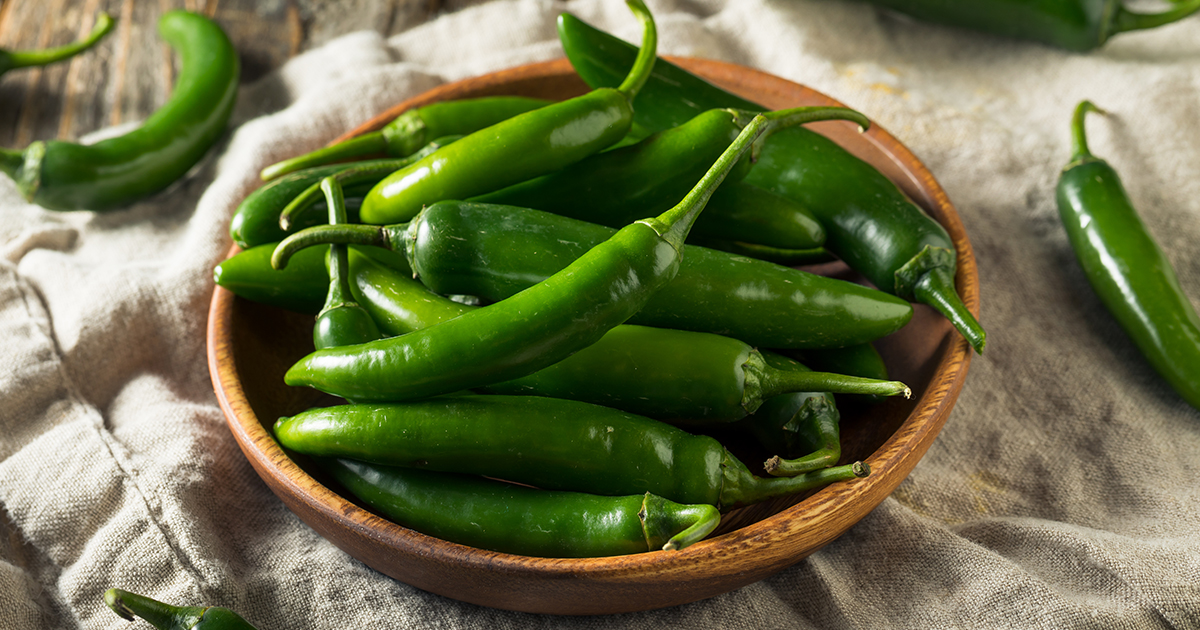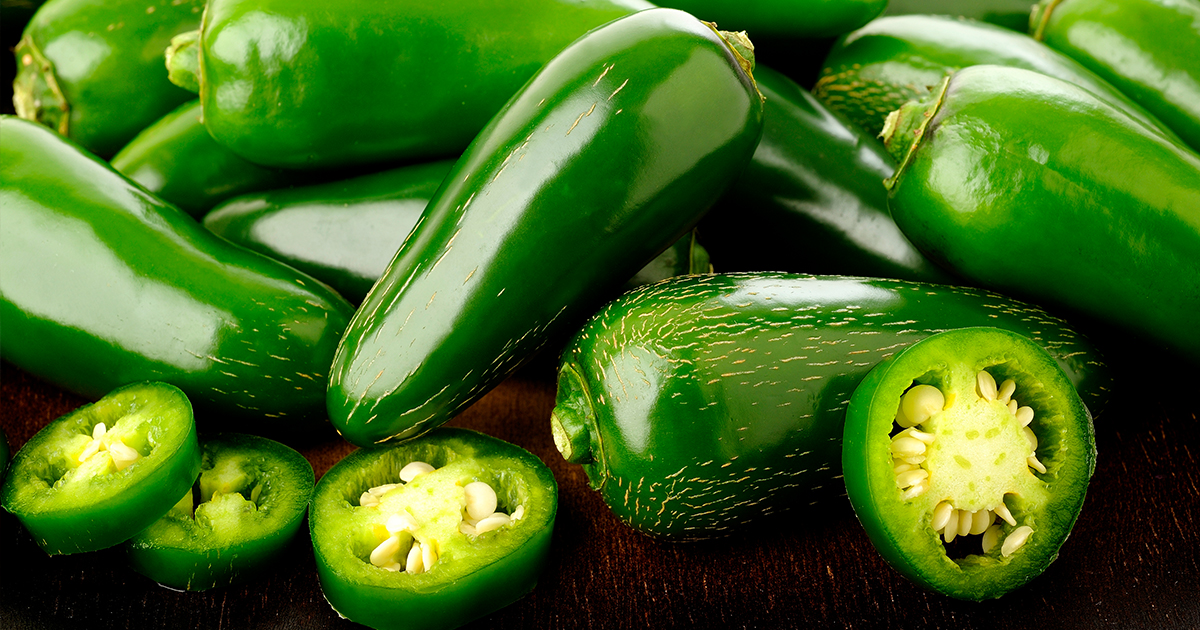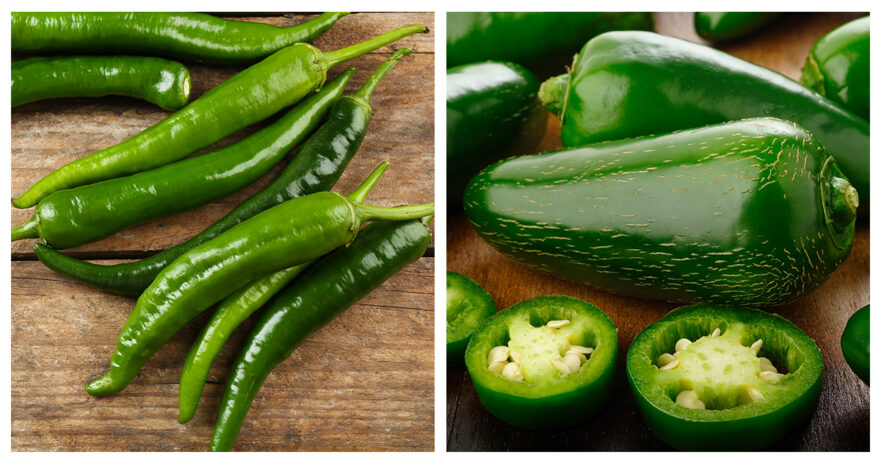If you have ever wondered what the differences between a serrano pepper and a jalapeño pepper are, then look no further! While they both come from the same species, they both have an array of distinct features that make them truly unique.
Whether you’re a spice aficionado or love adding a little kick to your meals, knowing the difference between these peppers will help you transform your meals. From heat levels and flavors to their uses and nutritional values, in this blog, we’ve taken a closer look to help you on your next cooking adventure.
| Serrano pepper | Jalapeño pepper | |
| SHU | 10,000 - 23,000 | 2,500 - 8,000 |
| Median SHU | 16,500 | 5,250 |
| Flavor | Crisp, bright, vegetable and notably hot | Grassy, vegetale, slightly sweet, and moderately spicy |
| Species | Capsicum annuum | Capsicum annuum |
| Origin | Mexico | Mexico |
| Uses | Salsas, sauces, pico de gallo, pickling, giardiniera, etc. | Salsas, guacamole, nachos, jalapeño poppers, etc. |
Table of contents
What is Serrano Pepper?

Serrano peppers are small and thin chili pepper and are known for their glossy green color. As a member of the Capsicum annuum species and originally come from the mountainous regions of Mexico, although nowadays they are cultivated across the globe. Although they might be small, they have a rating between 10,000 and 23,000 on the Scoville scale, which makes them far hotter than jalapeños.
Their bright, fresh, crisp and slightly fruity taste makes them very popular in a range of cuisines, including Thai, Indian, and Mexican, although they are less commonly used in the United States. The peppers are often used to add heat and flavor to salsas, marinades, dressings, soups, stews, and chilis as well as many types of Mexican street food, including tacos, burritos, and quesadillas.
Serranos can also be pickled for use as a condiment or occasionally stuffed and baked, although their smaller size means this is not as common compared to jalapeños.
What is Jalapeño Pepper?

Jalapeño peppers are one of the most popular varieties of chili peppers in the world. These medium-sized peppers have a thick, waxy green skin and an instantly-recognizable conical shape. As part of the Capsicum annuum species, they are also believed to have originated in Mexico but can now be found worldwide.
Jalapeños have a heat level between 2,500 and 8,000 on the Scoville scale, which makes them milder than serrano peppers. Their grassy and slightly sweet flavor provides a gentler heat and a crisp, fresh taste making them fantastic for use in a wide range of dishes.
They are a staple in Mexican cuisine and are used in a variety of dishes to add heat and flavor, including tacos, burritos, nachos, enchiladas, salsas, guacamoles, and other dips. They can also be pickled and used to add a tangy kick to sandwiches and burgers or even used to make spicy cocktails or as a garnish for Bloody Marys!
When stuffed and baked or grilled, they make a very popular appetizer or side dish with some of the most popular fillings including cream cheese, cheddar cheese, and bacon. In recent years, jalapeños have also become popular in non-Mexican cuisines, appearing in dishes like jalapeño popper pizza and jalapeño mac and cheese or to add heat to soups and stews.
What are the similarities between Serrano and Jalapeño peppers?
There are many similarities between jalapenos and serranos, with both being very versatile and capable of offering a unique flavor and depth to your cooking. Serrano peppers tend to have a bright and fresh flavor, while jalapeño peppers have a grassy and slightly sweet flavor.
Both options are also relatively easy to grow at home and can be cultivated in gardens and pots without requiring much care. They also have a very long shelf life and can be safely stored for an extended period which makes them a popular choice for amateur gardeners.
Another similarity is their versatility and ability to be used in a variety of mild and spicy dishes. From eating them raw to grilling them, roasting them, or sautéeing them, the options are endless and they also pair fantastically well with a wide range of other ingredients, including meat, vegetables, seafood, and cheese.
Both peppers are most commonly know for being a staple of traditional Mexican cuisine, which is known for its bold flavors. From dips such as salsa and guacamole to tacos and burritos, their versatility is now recognized across the globe.
Both peppers also tend to be one of the more visually appealing chili peppers thanks to their glossy green color and conical shape, allowing them to be used to add visual appeal to a dish.
What are the differences between Serrano and Jalapeño peppers?
The most significant difference between serrano and jalapeño peppers is their heat level. Serranos are much hotter, with a heat level of 10,000 to 23,000 on the Scoville scale compared to just 2,500 and 8,000 for jalapeños.
Visually, serrano peppers are smaller and thinner than jalapeño peppers, while they also have a brighter green color when unripe. This green begins to turn red, orange, or yellow as they ripen. Alongside being larger and thicker,
Jalapeños are a darker shade of green and turn red when mature.
Serranos tend to be used in Mexican cuisine, especially as an ingredient for sauces and salsa. Jalapeños are more versatile and can be stuffed, pickled, baked, or eaten as a topping for nachos, hotdogs, and pizzas.
While both do have a green and grassy taste, another notable difference is their flavor profile. A serrano pepper has a fruitier and brighter taste compared to jalapeños, allowing them to be used in a range of fresh dishes, including salads and ceviche.
When it comes to cooking, the heat level of these two peppers greatly impacts the flavor of a dish. With their intense heat, serranos can easily overpower a dish which is why they should be used in much smaller quantities. However, jalapeños are much softer and can be a great way to add a more manageable kick to your dish without overwhelming other ingredients.
FAQ about Serrano pepper VS Jalapeño
What is the main difference between Serrano and Jalapeño peppers?
Serrano peppers are hotter than jalapeño peppers, with a heat level ranging from 10,000 to 23,000 on the Scoville scale, compared to 2,500 to 8,000 for jalapeños. Serrano peppers also have a crispy, bright, and fresh flavor, whereas jalapeño peppers have a grassy and slightly sweet taste.
How do Serrano and Jalapeño peppers look different?
Serrano peppers are smaller and thiner and have a glossy green color whereas jalapeños are medium-sized with thick, waxy green skin and a conical shape.
What cuisines use Serrano and Jalapeño peppers?
Both are commonly used in traditional Mexican cuisine, while serrano peppers are also used in Thai and Indian cuisines.
In recent years, jalapeños have become popular in non-Mexican cuisines as well, appearing in everything from jalapeño popper pizzas to jalapeño mac and cheese.
How are Serrano and Jalapeño peppers used in cooking?
Both can be used in a variety of mild and spicy dishes. From roasting and grilling to pickling or eating raw, they are incredibly versatile and pair well with meat, seafood, vegetables, and cheese.
Can Serrano and Jalapeño peppers be used interchangeably?
While they have different levels of heat and flavor, serrano and jalapeño peppers can be used interchangeably in most recipes. However, it is important you remember to adjust the amount being used to ensure you can achieve the same level of heat.
Can Serrano and Jalapeño peppers be frozen?
Yes, you can freeze both peppers for future use. First, you should remove the stem and seeds and then wash and dry them thoroughly. After that, place them in an airtight container or freezer bag and store for up to six months.
What are some recipes that use Serrano and Jalapeño peppers?
Both peppers are incredibly versatile and can be used in many different dishes. You will most commonly find them being used in everything from salsa, guacamole, tacos, and burritos to soups, stews, chili, and even spicy cocktails. They can also be stuffed and baked or grilled with fillings like cream cheese, cheddar cheese, and bacon.
